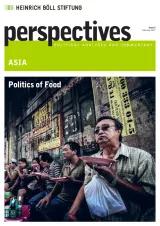Perspectives Asia: Politics of Food
What we eat is determined by more than just our preferences. Food choices are shaped by availability, culture and global economic structures. Tradition and wealth can influence what we eat, just as trade and foreign investments can influence our access to food. Due to the high degree of economic interdependence, the purchase of a food product in one country can affect the price development in another, ultimately restricting food choices. In short: Food is a highly political issue. Nowhere is this more true than in Asia.
Asia’s rapid economic development in the last two decades fundamentally altered the patterns of food consumption and availability for large parts of Asian societies. Despite the growth in wealth and the correlating increase in calorie intake, many governments still have difficulties providing food security to large portions of the population. Impressive growth rates and the rise of metropolises cannot hide the fact that Asia remains home to three-fifths of the world’s undernourished people, amounting to 512 million adults and children that
consume too few calories.
When it comes to the subject of food policies, Asia has two faces. While the rural and agrarian parts of Asia continue to struggle with old, familiar problems, such as the lack of access to food and nutrient deficiency, the richer, urban and more industrialized Asia is confronted with a different form of malnutrition stemming from unhealthy food products. Policymakers are thus forced to think about how to meet the different nutritional needs of people and what it means for a society when traditional food production and consumption habits are suddenly replaced.
This wide range of topics shows that food politics in Asia has become more than simply a matter of production and distribution. In effect, politics in Asia often deals with ethical, cultural and environmental disputes between different stakeholders when it comes to questions of food and nutrition. Establishing modern value chains and introducing new food products bears the risk of driving out small-scale famers, while new eating patterns might conflict with religious beliefs. At the same time, Asia’s growing appetite presses increasingly hard against the finite bounds of the planet’s natural resources, and in some regions, the consequences of climate change have forced governments to consider alternative approaches to food production.
As a result, international actors need to work together to improve food availability and safety, put pressure on decision makers, empower local communities and find solutions for a healthier and self-selected diet for all.
Product details
Table of contents
Introduction
- Are we junking the forest for poor nutrition?
Janice Ser Huay Lee - Contract farming in Myanmar: From expectations to exploitation
Nwet Kay Khine - China’s overseas agricultural investments: Not what it appears
Feifei Cai - The limits of industrial food strategies and alternatives
Shefali Sharma and Ginger Fletcher Santillan - Street food in Asia: An industry that is much better than its reputation
Florentinus Gregorius Winarno - «In India nationalism is defined by what you eat»
An Interview with Veena Shatrugna by Sadia Sohail - Gendered food insecurity: The legal and social foundations for women’s food discrimination in Afghanistan
Weeda Mehran - Zero political power for zero hunger in Pakistan: How food security is undermined by political power plays
Abid Suleri
